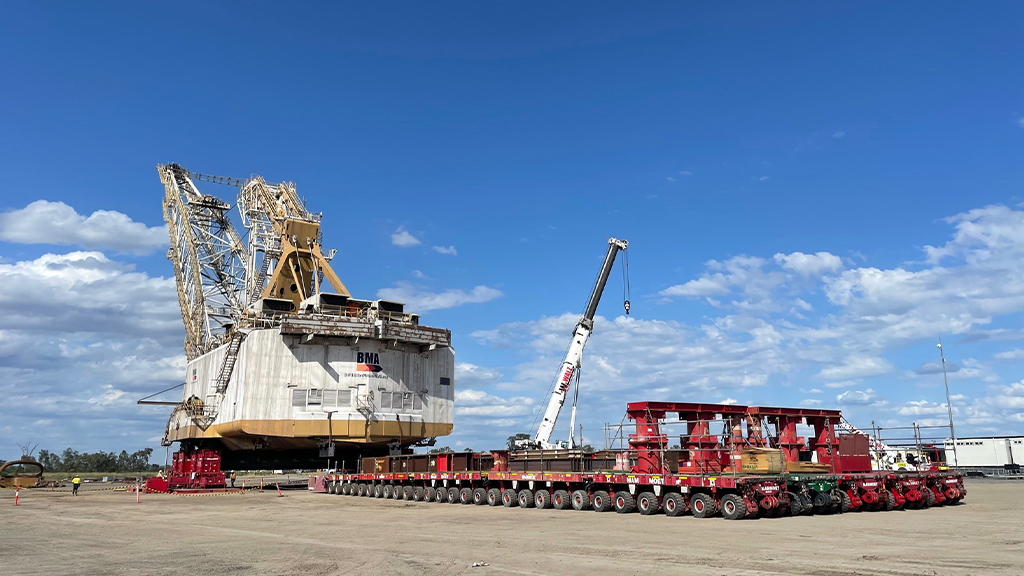BHP Mitsubishi Alliance (BMA) worked with Mammoet to relocate a 3,100-tonne Marion 8050 dragline from one end of the Peak Downs coal mine in Queensland, Australia, to another site 27 kilometres away.
Draglines are key pieces of equipment used in open-pit mining in Australia. These excavation giants are big, heavy, and powerful, making them challenging to move.
Designed to operate on one mine site, with an inability to efficiently travel long distances under their own steam, these massive, electric mining machines require ancillary transmission and generation equipment to move between dig sites.
With a deadline to achieve the relocation, it was sub-optimal to allow the dragline to travel under its own steam.
The solution? Jack up the dragline so it could be carried by Mammoet Self-Propelled Modular Transporters (SPMTs), travelling up to 5km per hour. In comparison, a dragline can cover approximately 1km in 12 hours.
This approach was used once before by Mammoet in Australia in 2017, also with BMA. This time, however, failure to cross a rail line by a certain deadline would result in considerable downtime and cost to the project.
Additionally, with extra equipment needed to complete the job and all imports subject to strict customs requirements, Mammoet would need to call on its global expertise and fleet to ensure smooth execution.
Eight JS500 towers were set up underneath the dragline for the jacking operation. Once it was elevated to 2.5 metres, a configuration of 5×28 lines of SPMT were positioned underneath the load to transport it.
For the jacking stage, it was vital that the engineers understood the weight and centre of gravity of the machine. Due to the dragline's age, information about it was limited, so they worked from a starting point of what was available for machines of a similar age.
While there were some nuances, the dragline was safely and efficiently lifted. Its weight was evenly distributed across 560 tires, resulting in a ground bearing pressure of less than 9t/m².
BMA constructed a new route for the dragline to take. Where there were soft areas in the soil, steel mats were used to prevent the SPMTs from digging in and getting stuck.
Due to the distance and intense Queensland heat, a canopied seat was installed on the deck of the front SPMT. This meant the control box could be mounted instead of carried, and the driver could be shielded from the sun.
The team had a 72-hour window for the railway line closure. In that time, they had to construct the temporary ramp over the track, make the crossing safely, and return everything back to its original state.
"In the past, dragline jacking in Australia has been performed using climbing jacks, which require manual handling of timber stacks to gradually lift the load," explains Jack Whittaker, project manager at Mammoet.
"One of the key reasons that BMA reached out to us was because the Aurizon rail crossing is a critical line, transporting coal from different mines in the region to the coast for exporting," adds Laura Ewen, branch manager at Mammoet.
Using SPMTs not only reduced risk for the project and got the dragline to the site safely, on time, and without incident, but it also reduced wear and tear on the machine and its mechanical parts.
The other benefit of this method was logistical; the ancillary equipment required to move a dragline, along with a portable substation connected via a long ‘umbilical' cable linked directly to overhead power cables on site, was not needed because everything was powered by the SPMTs.
Typically requiring over a month to transport, Mammoet has now set a new benchmark for dragline transportation by relocating this unit 27km to Peak Downs Mine in just 10 days, achieving 8km per day and significantly minimizing downtime for the Marion 8050.
12920 – 33 Street NE
Edmonton, AB
CA, T6S 1H6
Website:
mammoet.com
Queensland,
AU,
Website:
bhp.com
